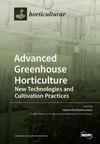Non-Destructive Detection of Cerasus Humilis Fruit Quality by Hyperspectral Imaging Combined with Chemometric Method
IF 3.1
3区 农林科学
Q1 HORTICULTURE
引用次数: 0
Abstract
Cerasus Humilis fruit is susceptible to rapid color changes post-harvest, which degrades its quality. This research utilized hyperspectral imaging technology to detect and visually analyze the soluble solid content (SSC) and firmness of the fruit, aiming to improve quality and achieve optimal pricing. Four maturity stages (color turning stage, coloring stage, maturity stage, and fully ripe stage) of Cerasus Humilis fruit were examined using hyperspectral images (895–1700 nm) alongside data collection on SSC and firmness. These samples were divided into a calibration set and a validation set with a ratio of 3:1 by sample set partitioning based on the joint X-Y distances (SPXY) method. The original spectral data was processed by a spectral preprocessing method. Multiple linear regression (MLR) and nonlinear least squares support vector machine (LS-SVM) detection models were established using feature wavelengths selected by the successive projections algorithm (SPA), competitive adaptive reweighted sampling (CARS), uninformative variable elimination (UVE), and two combined downscaling algorithms (UVE-SPA and UVE-CARS), respectively. For SSC and firmness detection, the best models were the SNV-SPA-LS-SVM model with 18 feature wavelengths and the original spectra-UVE-CARS-LS-SVM model with eight feature wavelengths, respectively. For SSC, the correlation coefficient of prediction (Rp) was 0.8526, the root mean square error of prediction (RMSEP) was 0.9703, and the residual prediction deviation (RPD) was 1.9017. For firmness, Rp was 0.7879, RMSEP was 1.1205, and RPD was 2.0221. Furthermore, the optimal model was employed to retrieve the distribution of SSC and firmness within Cerasus Humilis fruit. This retrieved information facilitated visual inspection, enabling a more intuitive and comprehensive assessment of SSC and firmness at each pixel level. These findings demonstrated the effectiveness of hyperspectral imaging technology for determining SSC and firmness in Cerasus Humilis fruit. This paves the way for online monitoring of fruit quality, ultimately facilitating timely harvesting.利用高光谱成像结合化学计量学方法对胡桃果实质量进行非破坏性检测
Cerasus Humilis 果实在采收后很容易迅速变色,从而降低其质量。本研究利用高光谱成像技术检测和直观分析果实的可溶性固形物含量(SSC)和坚实度,旨在提高质量,实现最佳定价。利用高光谱图像(895-1700 纳米)检测了 Cerasus Humilis 果实的四个成熟阶段(转色阶段、着色阶段、成熟阶段和完全成熟阶段),同时收集了 SSC 和硬度数据。通过基于联合 X-Y 距离 (SPXY) 方法的样本集划分,将这些样本按 3:1 的比例分为校准集和验证集。原始光谱数据采用光谱预处理方法进行处理。利用连续投影算法(SPA)、竞争性自适应加权采样(CARS)、无信息变量消除(UVE)和两种组合降尺度算法(UVE-SPA 和 UVE-CARS)选择的特征波长,分别建立了多元线性回归(MLR)和非线性最小二乘支持向量机(LS-SVM)检测模型。在 SSC 和硬度检测方面,最佳模型分别是具有 18 个特征波长的 SNV-SPA-LS-SVM 模型和具有 8 个特征波长的原始光谱-UVE-CARS-LS-SVM 模型。对于 SSC,预测相关系数(Rp)为 0.8526,预测均方根误差(RMSEP)为 0.9703,残差预测偏差(RPD)为 1.9017。坚固度的 Rp 为 0.7879,RMSEP 为 1.1205,RPD 为 2.0221。此外,还采用了最优模型来检索 Cerasus Humilis 果实内 SSC 和硬度的分布情况。检索到的信息有助于目测,从而能够更直观、更全面地评估每个像素级的 SSC 和硬度。这些研究结果表明,高光谱成像技术在确定葎草果实的 SSC 和坚实度方面非常有效。这为在线监测果实质量铺平了道路,最终有助于及时采收。
本文章由计算机程序翻译,如有差异,请以英文原文为准。
求助全文
约1分钟内获得全文
求助全文

 求助内容:
求助内容: 应助结果提醒方式:
应助结果提醒方式:


